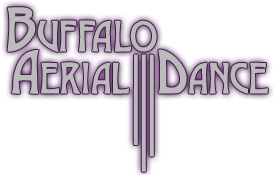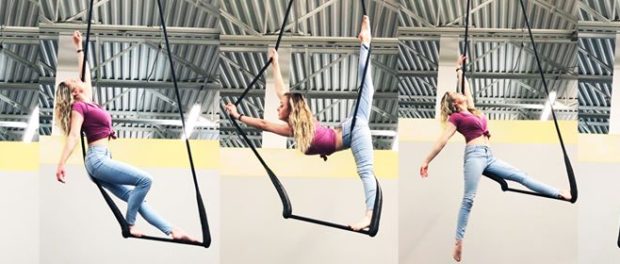Return to the Skies and a Trapeze Named Tina
By Jess Bennett
Last February, BAD put on a spectacular student showcase, and thanks to our generous audience, ticket sales afforded us a brand new trapeze. As your resident trapeze specialist, I was given the honor of speccing and placing the custom order for the new apparatus. She was going to be beautiful – dressed all in black, long, nine-foot ropes included. She arrived to my home March 14th…and everything shut down March 16th. So for three months, she and I were roomies. Having a trapeze at home was convenient for at-home video-making purposes (see floor trapeze here), but trapezes and trapeze artists are meant to be in the air, and we were grounded.
A grounded aerialist is not a happy camper. Aerial is so much more than exercise or a side job to me. It’s my therapy, creative outlet, stress management, and one of my biggest passions. The studio often feels more like home than where I reside and the team is my family. There is nothing like being in the air. I started gymnastics training when I was three years old. My body doesn’t know what it is to NOT be in the air – bending, flipping, and flying is my natural way of life.
I kept relatively active and healthy during the shutdown – my job is essential so I was going to work every day and at times, my job can be pretty active, but there are aerial muscles you just don’t use any other way. Would I lose strength? Flexibility? Like the rest of the unprecedented state of the world, there were no answers. Through the first month, I wasn’t really worried. At the end of January 2019, I had surgery and had to break from everything for a month, but when I came back, I had no trouble. I figured if I could come back from a month break with abdominal incisions and everything else my body had gone through, I’d be fine after a month break with no other physical complications.
No one expected this would go on over three months. I had no idea what it would be like the first time I got on a trapeze after that long. In preparation for reopening, I brought the new trapeze, Tina (short for Quarantina), to the studio for rigging one day in June. Being up there was pure joy! But on day one, I really hadn’t come to train (as is evident by my being in jeans). So what would it be like the first time I got serious after such a long break?

What I found was, I really didn’t lose much, if any, physical ability and muscle memory is a wonderful thing. My body still knew how to do everything and had what it needed to do so. The big difference between three months ago and now had nothing to do with muscle, tendons, or even calluses. The biggest setback I faced was in my mind.
Previous to the break, I was relatively fearless on a trapeze. That’s not to be confused with reckless. I have a healthy respect for the inherent danger of aerial work and always train safely. But when your body has trained acrobatic skills for *mumbles large number of years as to not reveal my age,* things that you know are dangerous don’t feel as risky. I know my body, I know my apparatus, I know my skill. It’s risk, but it’s extremely calculated risk, mitigated heavily by many factors. But after my feet had stayed on the ground for three months? Everything felt way scarier.
I LOVE inversions in the ropes (handstands and other upside-down skills). Inverting for me is so natural, it’s practically automatic. But the first time I inverted after the break, I felt a pang of intimidation. It quickly subsided once I went through with my usual inversion sequence, but as I’ve continued taking inventory of my skills, I find most things come with that little twinge of apprehension upon initial attempt. My big, crowd-pleasing drop is essentially three backward flips in a layout position. The first time I set up to do a single one of those flips, it was way scarier than the last time I did three. It’s partly that I’m working on a brand new trapeze and getting used to its unique feel, but it’s also partly that when triple backflips fifteen feet in the air (as shown here) are commonplace and then suddenly they’re not, it takes a minute for them to feel normal again.
So as we return to life and training, know that things may feel different and that’s ok. Give your body time to adjust, and just as importantly, give your mind that same space. We’re here with you every step, climb, spin, and flip of the way.
Note from the studio director: I asked Jess to write this piece because I know for many aerialists, our training is a fundamental part of our identity, and there have been so many people who have expressed fear of losing the skills that they worked so incredibly hard to gain. I knew she had some perspective on this from prior experiences. It is exciting that we are now able to offer some classes again, but to pretend that everything has gone back to normal would be utter folly. Aerialists are used to thinking about risk, but COVID-19 has presented categories of risk that are very difficult for anyone, even the experts, to navigate. I did not take the decision to “re-open” the studio lightly, and the path through the current situation is likely to continue to be a rocky road.
In an attempt to figure out how we can adapt our usual ways of training into something that can be done in a pandemic, I decided to offer some limited training opportunities, especially geared towards those who live and breathe this artform. There are many concerns with being open, as well as with being closed, and we are all doing our very best to balance all of those. If you do decide you want to train, be assured that we are taking precautions at the studio. However, for those who believe the risks are still to great, I feel you too, and there are many great opportunities to work on skills from home. Feel free to reach out to me for options!

